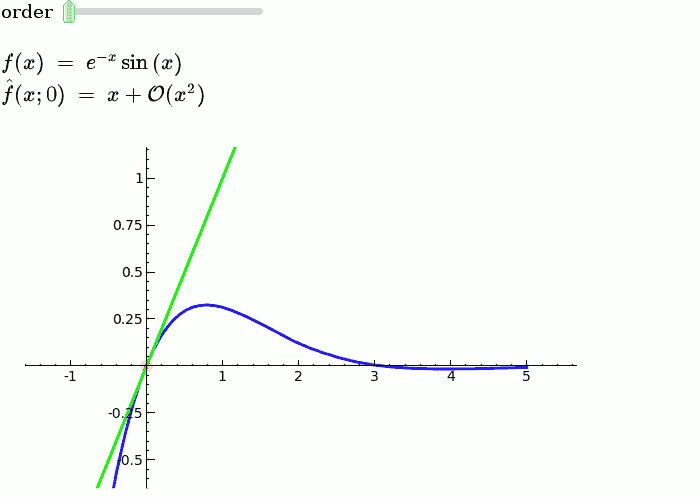|
Size: 2906
Comment:
|
Size: 2004
Comment:
|
| Deletions are marked like this. | Additions are marked like this. |
| Line 3: | Line 3: |
| Post code that demonstrates the use of the interact command in Sage here. It should be easy to just scroll through and paste examples out of here into their own sage notebooks.If you have suggestions on how to improve interact, add them [:interactSuggestions: here] or email [email protected]. | This is a collection of pages demonstrating the use of [[http://sagemath.org/doc/reference/sagenb/notebook/interact.html#sagenb.notebook.interact.interact|the interact command]] in Sage. It should be easy to just scroll through and copy/paste examples into Sage notebooks. If you have suggestions on how to improve interact, add them [[interactSuggestions|here]] or email [email protected] . Of course, your own examples are also welcome! |
| Line 5: | Line 5: |
| * [:interact/graph_theory:Graph Theory] * [:interact/calculus:Calculus] * [:interact/diffeq:Differential Equations] * [:interact/linear_algebra:Linear Algebra] * [:interact/algebra:Algebra] * [:interact/number_theory:Number Theory] * [:interact/web:Web Applications] * [:interact/bio:Bioinformatics] * [:interact/graphics:Drawing Graphics] |
* [[interact/algebra|Algebra]] * [[interact/bio|Bioinformatics]] * [[interact/calculus|Calculus]] * [[interact/chemistry|Chemistry]] * [[interact/diffeq|Differential Equations]] * [[interact/graphics|Drawing Graphics]] * [[interact/dynsys|Dynamical Systems]] * [[interact/fractal|Fractals]] * [[interact/games|Games and Diversions]] * [[interact/geometry|Geometry]] * [[interact/graph_theory|Graph Theory]] * [[interact/linear_algebra|Linear Algebra]] * [[interact/Loop Quantum Gravity]] * [[interact/misc|Miscellaneous]] * [[interact/number_theory|Number Theory]] * [[interact/stats|Statistics/Probability]] * [[interact/topology|Topology]] * [[interact/web|Web Applications]] |
| Line 15: | Line 24: |
| == Miscellaneous == | == Explanatory example: Taylor Series == |
| Line 17: | Line 26: |
| == Profile a snippet of code == {{{ html('<h2>Profile the given input</h2>') import cProfile; import profile |
This is the code and a mockup animation of the interact command. It defines a slider, seen on top, that can be dragged. Once dragged, it changes the value of the variable "order" and the whole block of code gets evaluated. This principle can be seen in various examples presented on the pages above! {{{#!sagecell var('x') x0 = 0 f = sin(x)*e^(-x) p = plot(f,-1,5, thickness=2) dot = point((x0,f(x=x0)),pointsize=80,rgbcolor=(1,0,0)) |
| Line 22: | Line 35: |
| def _(cmd = ("Statement", '2 + 2'), do_preparse=("Preparse?", True), cprof =("cProfile?", False)): if do_preparse: cmd = preparse(cmd) print "<html>" # trick to avoid word wrap if cprof: cProfile.run(cmd) else: profile.run(cmd) print "</html>" |
def _(order=(1..12)): ft = f.taylor(x,x0,order) pt = plot(ft,-1, 5, color='green', thickness=2) html('$f(x)\;=\;%s$'%latex(f)) html('$\hat{f}(x;%s)\;=\;%s+\mathcal{O}(x^{%s})$'%(x0,latex(ft),order+1)) show(dot + p + pt, ymin = -.5, ymax = 1) |
| Line 32: | Line 42: |
| attachment:profile.png === Evaluate a bit of code in a given system === by William Stein (there is no way yet to make the text box big): {{{ @interact def _(system=selector([('sage0', 'Sage'), ('gp', 'PARI'), ('magma', 'Magma')]), code='2+2'): print globals()[system].eval(code) }}} attachment:evalsys.png === A Random Walk === by William Stein {{{ html('<h1>A Random Walk</h1>') vv = []; nn = 0 @interact def foo(pts = checkbox(True, "Show points"), refresh = checkbox(False, "New random walk every time"), steps = (50,(10..500))): # We cache the walk in the global variable vv, so that # checking or unchecking the points checkbox doesn't change # the random walk. html("<h2>%s steps</h2>"%steps) global vv if refresh or len(vv) == 0: s = 0; v = [(0,0)] for i in range(steps): s += random() - 0.5 v.append((i, s)) vv = v elif len(vv) != steps: # Add or subtract some points s = vv[-1][1]; j = len(vv) for i in range(steps - len(vv)): s += random() - 0.5 vv.append((i+j,s)) v = vv[:steps] else: v = vv L = line(v, rgbcolor='#4a8de2') if pts: L += points(v, pointsize=10, rgbcolor='red') show(L, xmin=0, figsize=[8,3]) }}} attachment:randomwalk.png === 3D Random Walk === {{{ @interact def rwalk3d(n=(50,1000), frame=True): pnt = [0,0,0] v = [copy(pnt)] for i in range(n): pnt[0] += random()-0.5 pnt[1] += random()-0.5 pnt[2] += random()-0.5 v.append(copy(pnt)) show(line3d(v,color='black'),aspect_ratio=[1,1,1],frame=frame) }}} attachment:randomwalk3d.png |
{{attachment:taylor_series_animated.gif}} |
Sage Interactions
This is a collection of pages demonstrating the use of the interact command in Sage. It should be easy to just scroll through and copy/paste examples into Sage notebooks. If you have suggestions on how to improve interact, add them here or email [email protected] . Of course, your own examples are also welcome!
Explanatory example: Taylor Series
This is the code and a mockup animation of the interact command. It defines a slider, seen on top, that can be dragged. Once dragged, it changes the value of the variable "order" and the whole block of code gets evaluated. This principle can be seen in various examples presented on the pages above!

